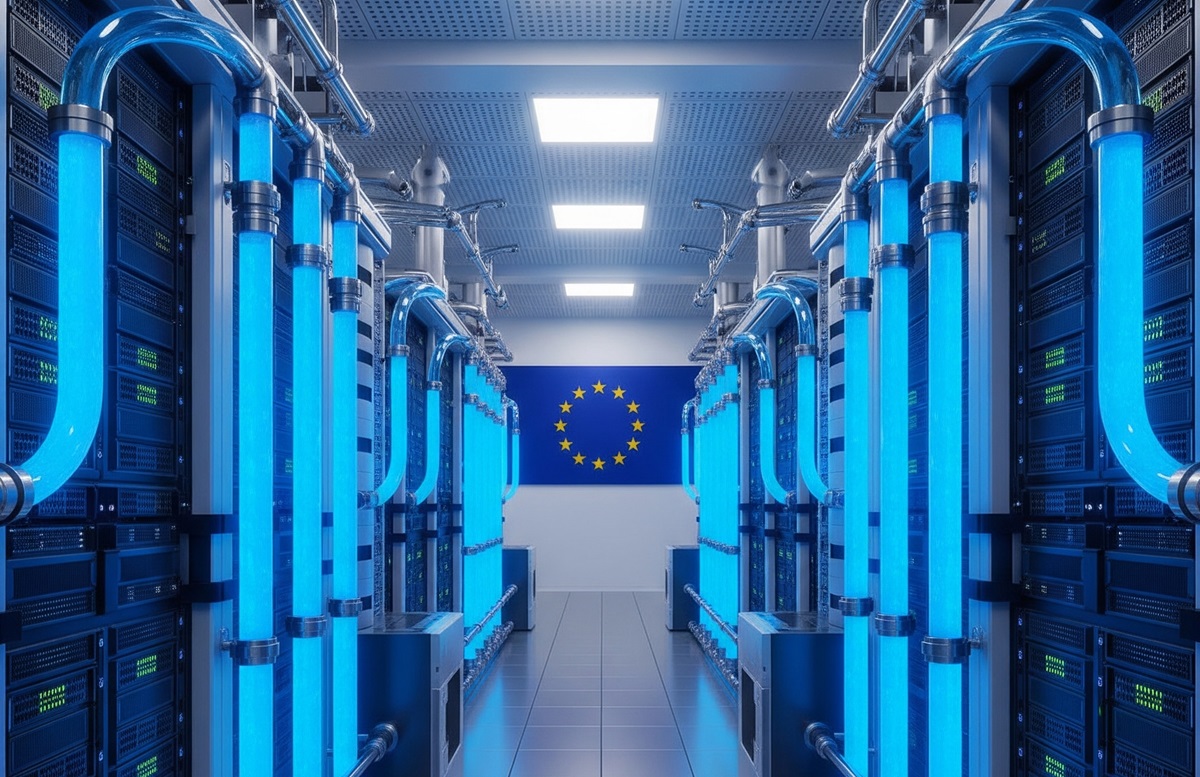Liquid Cooling for Data Centers: The EU’s Game-Changer for Energy Efficiency & AI Workloads

The relentless march of digital transformation has put data centers at the very heart of our modern world. From streaming movies to powering AI algorithms, these digital factories consume immense amounts of energy, with their demand projected to surge significantly in the coming years. A major contributor to this escalating energy footprint is the constant battle against heat—the inevitable byproduct of powerful computing. For decades, air cooling has been the industry standard, but as server densities skyrocket and the demands of high-performance computing (HPC) and artificial intelligence (AI) push hardware to its limits, traditional air-based systems are reaching their breaking point.
This escalating challenge, coupled with increasingly stringent environmental regulations, particularly within the European Union, is driving a profound shift in how data centers manage thermal loads. Enter liquid cooling for data centers—a transformative solution that is no longer just an alternative but an indispensable technology. This article will explore why liquid cooling is becoming a game-changer for EU data centers, directly addressing energy efficiency mandates and uniquely enabling the burgeoning demands of AI workloads. We’ll delve into its various forms, its direct link to EU compliance, its role in powering the AI revolution, its broader benefits, and the considerations for its widespread adoption.
- 1. The Data Center’s Energy Crisis: Why Air Cooling is Reaching Its Limit
- 2. Liquid Cooling Unveiled: Types and Principles for Ultimate Efficiency
- 3. The EU Mandate: How Regulations Make Liquid Cooling a Necessity, Not an Option
- 4. Powering AI’s Future: Liquid Cooling as the Engine for High-Density Workloads
- 5. Beyond PUE: The Holistic Benefits of Liquid Cooling for Sustainable Data Centers
- 6. Navigating the Transition: Challenges and Considerations for Adoption
- 7. The Future is Fluid: Market Trends and the Evolution of Data Center Cooling
- Conclusion: The Indispensable Role of Liquid Cooling in a Green & AI-Powered Future
- Frequently Asked Questions (FAQs) About Liquid Cooling for Data Centers
- Q1: What exactly is liquid cooling for data centers?
- Q2: How much more energy-efficient is liquid cooling compared to traditional air cooling?
- Q3: Why is liquid cooling essential for AI and HPC workloads?
- Q4: How do EU regulations, like the EED and AI Act, impact the adoption of liquid cooling?
- Q5: Can existing air-cooled data centers be retrofitted with liquid cooling?
1. The Data Center’s Energy Crisis: Why Air Cooling is Reaching Its Limit
Data centers are notorious energy consumers, and a significant portion of that energy is dedicated not to computing but to cooling. As technology advances, the problem only intensifies:
- Escalating Power Density: Modern servers are packing more processing power, more GPUs, and more memory into increasingly smaller footprints. A single rack can now generate upwards of 30 kW of heat, with some high-density AI racks pushing well over 100 kW. Traditional air cooling infrastructure, designed for lower densities, simply can’t cope efficiently.
- Inefficiencies of Air Cooling: Air is a poor conductor of heat. Air cooling systems, relying on massive fans, Computer Room Air Handlers (CRAHs), Computer Room Air Conditioners (CRACs), and chillers, consume vast amounts of electricity. Cooling can account for anywhere from 30% to 40% or more of a data center’s total energy bill, making it a prime target for efficiency improvements.
- Thermal Hotspots: Even with optimized airflow, air cooling struggles to uniformly dissipate heat from high-density racks, leading to “hotspots” that can degrade equipment performance (thermal throttling) and potentially lead to failures.
These limitations highlight the urgent need for a more effective and energy-efficient thermal management solution.
2. Liquid Cooling Unveiled: Types and Principles for Ultimate Efficiency
Liquid cooling for data centers leverages the fundamental principle that liquid is vastly more efficient at absorbing and transferring heat than air—by some estimates, up to 1,000 times more effective. This superior heat transfer capability allows for far greater energy efficiency and thermal management.
There are several primary types of liquid cooling gaining traction:
- Direct Liquid Cooling (DLC) / Direct-to-Chip: This method involves routing coolant through cold plates that are mounted directly onto the hottest components, such as CPUs, GPUs, and memory modules. It’s highly targeted, allowing for precise heat removal where it’s most concentrated. DLC can often be retrofitted into existing air-cooled environments, creating a hybrid cooling approach.
- Immersion Cooling: In this highly efficient method, IT servers and components are fully submerged in tanks filled with a non-conductive dielectric fluid. The fluid directly absorbs heat from all submerged components. Immersion cooling offers the highest heat removal capacity and allows for extreme rack densities. Since components are submerged, server fans are eliminated, further reducing energy consumption and noise.
- Rear Door Heat Exchangers (RDHx): These systems incorporate liquid-cooled coils into the back doors of server racks. Hot air exiting the servers passes through these coils, where the heat is transferred to the liquid, cooling the air before it re-enters the data center environment. RDHXs are a good bridge solution for moderate- to high-density racks.
Many data centers adopt hybrid systems, utilizing liquid cooling for high-density racks and air cooling for less demanding areas, optimizing efficiency across the entire facility.
3. The EU Mandate: How Regulations Make Liquid Cooling a Necessity, Not an Option
The European Union is at the forefront of driving data center sustainability, transforming liquid cooling from a desirable upgrade into a strategic imperative.
- EU Energy Efficiency Directive (EED III): This directive mandates detailed annual reporting on energy consumption, water usage (WUE), and waste heat utilization (ERF) for all data centers with an IT power demand above 500 kW. The first reports for 2023 data were due by May 2024. While the EED doesn’t explicitly mandate liquid cooling, achieving the required efficiency metrics (e.g., lower PUE, higher ERF) strongly pushes operators towards advanced cooling solutions that can deliver significant energy savings.
- EU AI Act: This landmark regulation introduces a crucial link between AI development and environmental impact. It requires providers of general-purpose AI (GPAI) models to document their energy consumption. Given that AI training consumes immense power and generates intense heat, this mandate directly encourages the adoption of highly efficient cooling technologies like liquid cooling to manage AI workloads sustainably.
- Climate Neutrality Goals: Broader EU initiatives, like the European Green Deal, and national targets (e.g., Germany’s ambitious goal of a 1.2 PUE for all new data center builds) demand a drastic reduction in data center carbon footprints. Liquid cooling’s ability to lower PUE and enable large-scale waste heat recovery is pivotal for meeting these stringent climate-neutrality targets.
- Green Deal & Digital Strategy: These overarching strategies underscore the EU’s commitment to sustainable digital infrastructure, making liquid cooling a key enabler for data centers looking to operate in a compliant and competitive European market.
4. Powering AI’s Future: Liquid Cooling as the Engine for High-Density Workloads
The explosion of artificial intelligence, machine learning (ML), and high-performance computing (HPC) has created a new challenge that traditional air cooling simply cannot meet: extreme heat.
- Unprecedented Heat Generation: AI workloads, particularly those leveraging powerful GPUs and TPUs, generate incredibly concentrated heat. A single rack of AI servers can produce many times the heat of a standard rack, quickly overwhelming air-based cooling systems.
- Preventing Thermal Throttling: Without effective cooling, AI processors can overheat, leading to “thermal throttling”—where “the hardware automatically slows down to prevent damage. This severely degrades performance and wastes energy. Liquid cooling maintains stable, optimal operating temperatures, ensuring AI hardware runs continuously at peak performance.
- Maximizing Performance and Density: By efficiently removing heat, liquid cooling allows data centers to maximize computing power within a given footprint, enabling higher server densities and greater processing capacity without thermal limitations. This is crucial for scaling AI infrastructure cost-effectively.
5. Beyond PUE: The Holistic Benefits of Liquid Cooling for Sustainable Data Centers
While PUE (Power Usage Effectiveness) is a primary metric for energy efficiency, liquid cooling offers a much broader array of benefits, aligning perfectly with comprehensive sustainability goals:
- Dramatic PUE Reduction: Liquid cooling can reduce PUE to exceptionally low levels (e.g., 1.03-1.1), significantly cutting energy consumption related to cooling.
- Significant Waste Heat Recovery: The waste heat from liquid cooling is often at a higher temperature (e.g., 50-60°C for DLC) than air-cooled exhaust. This makes it ideal for direct reuse in district heating networks, industrial processes, or even power generation, vastly improving the Energy Reuse Factor (ERF) and overall carbon footprint.
- Reduced Water Consumption: Many closed-loop liquid cooling systems (e.g., immersion with dry coolers) use significantly less water than traditional evaporative cooling towers, addressing water scarcity concerns.
- Increased Equipment Longevity: Stable operating temperatures reduce thermal stress on components, extending hardware lifespan and reducing replacement costs and electronic waste.
- Space Savings: Higher server densities enabled by liquid cooling mean less physical space is required for the same computing power, optimizing real estate utilization.
- Noise Reduction: The elimination or significant reduction of large fans leads to quieter data center operations, improving working conditions.
6. Navigating the Transition: Challenges and Considerations for Adoption
While the benefits are clear, adopting liquid cooling involves certain considerations:
- Higher Initial Investment: The specialized infrastructure for liquid cooling can have a higher upfront cost compared to traditional air cooling.
- Infrastructure Changes: Retrofitting existing air-cooled data centers requires modifications to facility design, piping, and rack configurations.
- Deployment & Maintenance Complexity: Requires specialized knowledge for installation, fluid management, and ongoing maintenance. However, modern systems are highly reliable, mitigating leakage concerns.
- Standardization: While progress is being made, broader standardization across different liquid cooling technologies and vendors is an ongoing effort.
Despite these challenges, the long-term operational savings, compliance benefits, and enablement of high-density computing often outweigh the initial hurdles.
7. The Future is Fluid: Market Trends and the Evolution of Data Center Cooling
The trajectory for liquid cooling for data centers is one of rapid growth and increasing adoption.
- Continued Market Expansion: Driven by the insatiable demands of AI, HPC, IoT, and stricter regulatory environments (like the EU’s), the market for liquid cooling is projected to expand significantly. The European data center liquid cooling market alone is forecast to reach US$ 4,233.2 million by 2030, growing at a CAGR of 20.5% from 2025 to 2030.
- Standard for Hyperscale & Edge: Liquid cooling is fast becoming the default choice for new hyperscale and high-density edge data centers.
- Hybrid Solutions: A pragmatic approach, combining liquid cooling for high-density zones with air cooling for general IT, will likely remain prevalent.
- Integration with Renewable Energy: Expect closer ties between liquid cooling systems and renewable energy sources, especially for maximizing waste heat utilization and achieving 100% renewable energy targets.
Conclusion: The Indispensable Role of Liquid Cooling in a Green & AI-Powered Future
The EV charging revolution has fundamentally transformed perceived limitations into core strengths, making electric cars more accessible and appealing to a mainstream audience. The relentless pace of innovation, from lightning-fast chargers to intelligent bidirectional systems and seamless user experiences, is dissolving the final hurdles to mass EV adoption.
These advancements are not just technological marvels; they are critical enablers for accelerating the transition to clean transportation. As charging becomes faster, smarter, more convenient, and more widely available, the decision to go electric becomes easier for millions more drivers. The future of EV charging promises even greater speed, intelligence, and ubiquity, solidifying electric cars as the default choice for personal transportation and contributing significantly to a cleaner, more sustainable planet.
The liquid cooling revolution is now an indispensable force shaping the future of data centers. Driven by the critical demands of burgeoning AI workloads and the imperative of stringent EU energy efficiency and sustainability regulations, it is transforming data centers from energy-intensive facilities into models of efficiency and environmental responsibility. By drastically improving thermal management, enabling unprecedented computing densities, and facilitating significant energy and water savings, liquid cooling is empowering the digital age to thrive sustainably.
For data center operators and IT decision-makers, embracing liquid cooling is no longer just an option for efficiency; it’s a strategic imperative for compliance, competitiveness, and building future-proof infrastructure that can meet the demands of the digital economy while honoring our collective commitment to a greener planet.
Frequently Asked Questions (FAQs) About Liquid Cooling for Data Centers
Q1: What exactly is liquid cooling for data centers?
A: Liquid cooling uses a liquid (like water or a dielectric fluid) to directly remove heat from IT components, which is significantly more efficient than using air. It comes in types like direct liquid cooling (where coolant flows through cold plates on chips) and immersion cooling (where servers are submerged in fluid).
Q2: How much more energy-efficient is liquid cooling compared to traditional air cooling?
A: Liquid cooling can drastically reduce a data center’s PUE (Power Usage Effectiveness), often bringing it down from 1.5+ with air cooling to as low as 1.03-1.1. This is because liquid is far more effective at heat transfer than air, reducing the energy needed for cooling systems.
Q3: Why is liquid cooling essential for AI and HPC workloads?
A: AI and High-Performance Computing (HPC) workloads generate immense, concentrated heat from powerful GPUs and CPUs that air cooling struggles to dissipate. Liquid cooling effectively manages this extreme heat, preventing thermal throttling, enabling higher component density, and ensuring these critical workloads run at peak performance.
Q4: How do EU regulations, like the EED and AI Act, impact the adoption of liquid cooling?
A: EU regulations, including the Energy Efficiency Directive (EED), which mandates detailed reporting on data center energy and waste heat, and the AI Act, which requires energy consumption documentation for AI models, are pushing data centers towards greater efficiency. Liquid cooling is a key technology for meeting these mandates, helping to achieve lower PUEs and enabling significant waste heat recovery.
Q5: Can existing air-cooled data centers be retrofitted with liquid cooling?
A: Yes, many existing air-cooled data centers can be retrofitted with liquid cooling solutions, particularly Direct Liquid Cooling (DLC) or Rear Door Heat Exchangers (RDHx). This allows data centers to introduce liquid cooling selectively for high-density racks or specific components without completely overhauling their infrastructure.



